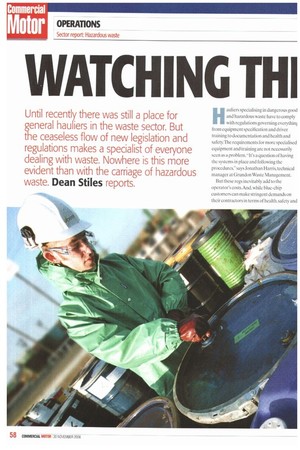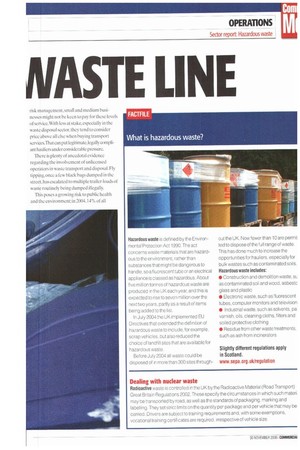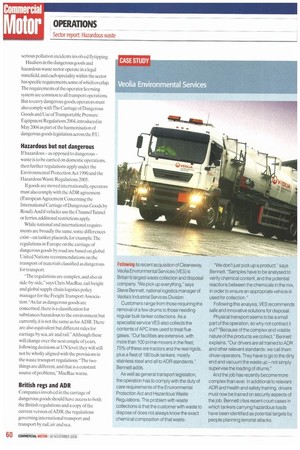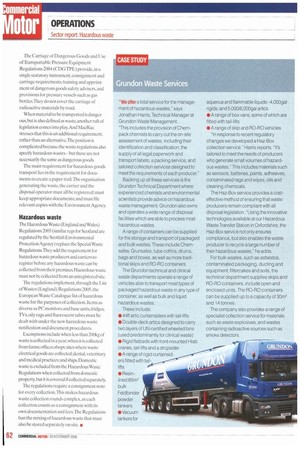WATCHING THU WASTE LINE
Page 58

Page 59

Page 60

Page 62

If you've noticed an error in this article please click here to report it so we can fix it.
Until recently there was still a place for general hauliers in the waste sector. But the ceaseless flow of new legislation and regulations makes a specialist of everyone dealing with waste. Nowhere is this more evident than with the carriage of hazardous
waste. Dean Stiles reports. Hauliers specialising in dangerous good and hazardous waste have to comply with regulations governing everythinl from equipment specification and driver training to documentation and health and safetyThe requirements for more specialised equipment and training are not necessarily seen as a problem."It's a question of having the systems in place and following the procedures," says Jonathan Harris, technical manager at Grundon Waste Management.
But these regs inevitably add to the operator's costs. And, while blue-chip customers can make stringent demands on their contractors in terms of health. safety and risk management, small and medium businesses might not be keen to pay for these levels of service, With less at stake, especially in the waste disposal sector. they tend to consider price above all else when buying transport services.That can put legitimate.legally compliant hauliers under considerable pressure.
There is plenty of anecdotal evidence regarding the involvement of unlicensed operators in waste transport and disposal. Fly tipping,once a few black bags dumped in the street has escalated to multiple trailer-loads of waste routinely being dumped illegally.
This poses a growing risk to public health and the environment: in 2004.14% of all serious pollution incidents involved flytipping.
Hauliers in the dangerous goods and hazardous waste sector operate in a legal minefield, and each speciality within the sector has specific requirements. some of which overlap. The requirements of the operator licensing system are common to all transport operations But to carry dangerous goods. operators must also comply with The Carriage of Dangerous Goods and Use of Transportable Pressure Equipment Regulations 2004, introduced in May 2004 as part of the harmonisation of dangerous goods legislation across the EU.
Hazardous but not dangerous
If hazardous as opposed to dangerous waste is to be carried on domestic operations, then further regulations apply under the Environmental Protection Act 1990 and the Hazardous Waste Regulations 2005.
If goods are moved internationally, operators must also comply with the ADR agreement (European Agreement Concerning the International Carriage of Dangerous Goods by Road).And if vehicles use the Channel Tunnel or ferries, additional restrictions apply.
While national and international requirements are broadly the same, some differences exist -on tanker placards. for example.The regulations in Europe on the carriage of dangerous goods by road are based on global United Nations recommendations on the transport of materials classified as dangerous for transport.
"The regulations are complex, and also sit side-by-side." says Chris MacRae.rail freight and global supply chain logistics policy manager for the Freight Transport Association."As far as dangerous goods are concerned, there is a classification for substances hazardous to the environment but currently, it is not the same as for ADR.There are also equivalent but different rules for carriage by sea, air and rail." Although these will change over the next couple of years, following decisions at UN level, they will still not be wholly aligned with the provisions in the waste transport regulations. "The two things are different, and that is a constant source of problems,MacRae warns.
British regs and ADR
Companies involved in the carriage of dangerous goods should have access to both the British regulations and a copy of the current version of ADR, the regulations governing international transport and transport by rail, air and sea. 'I'he Carriage of Dangerous Goods and Use ofTransportable Pressure Equipment Regulations 2004 (CDG TPE) provide, in a single statutory instrumen t, consignment and carriage requirements. training and appointment of dangerous goods safety advisers, and provisions for pressure vessels such as gas bottles.They do not cover the carriage of radioactive materials by road.
When material to be transported is dangerous, but is also defined as waste, another raft of legislation comes into play.And MacRae stresses that this is an additional requirement, rather than an alternative.The position is complicated because the waste regulations also specify hazardous wastes—but these are not necessarily the same as dangerous goods.
The main requirement for hazardous goods transport lies in the requirement for documents to create a paper trail:the organisation generating the waste, the carrier and the disposal operator must all be registered: must keep appropriate documents:and must file relevant copies with the Environment Agency.
Hazardous waste The hazardous Waste (England and Wales) Regulations 2005 (similar regs for Scotland are regulated by the Scottish Erwironmental Protection Agency) replace the Special Waste Regulations.They add the requirement for hazardous waste producers and carriers to register before any hazardous waste can be collected from their premises. Hazardous waste must not be collected from an unregistered site.
The regulations implement, through the List ofWastes (England) Regulations 2005. the European Waste Catalogue list of hazardous waste for the purposes of collection. Items as diverse as PC monitors and base units, fridges. TVs, oily rags and fluorescent tubes must be dealt with under the new hazardous waste notification and document procedures.
Exemptions include when less than 200kg of waste is collected in a year;when it is collected from farms; offices; shops; sites where waste electrical goods arc collected; dental, veterinary and medical practices: and ships. Domestic waste is excluded from the Hazardous Waste Regulations when collected from domestic property, but it is covered if collected separately.
The regulations require a consignment note for every collection.This makes hazardous waste collection rounds complex. as each collection counts as a consignment with its own documentation and fees.The Regulations ban the mixing of hazardous waste that must also be stored separately on site. •


















































































































































































